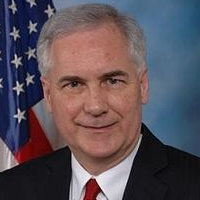Rep. McClintock Dismisses Budget Cuts, Blames Rim Fire in His District on Logging Foes
 Representative Tom McClintock
Representative Tom McClintock
California’s Rim Fire, which is wreaking havoc for a third week, was preceded by an array of fire prevention measures fueled by annual budget cuts and the 5% across-the-board sequester whack. For instance, Reuters reported funding cuts short-circuited eight planned controlled burns by the U.S. Forest Service in the 25-square-mile Groveland District of the Stanislaus National Forest, wiped out by the Rim Fire.
Politicians in California, where 92,968 acres out in the woods are identified annually for thinning, generally have a heightened interest in preserving forest areas, and are especially attentive when the woods on fire are in their district, like U.S. Representative Tom McClintock, a three-term conservative Republican.
McClintock, who works in the legislative chamber that originates budget measures, does not believe that funding cuts to the Forest Service contributed to the fire. He wrote a note to the San Francisco Chronicle, which warned them about buying into, “the old sequester song and dance—it doesn’t pass the smell test.”
McClintock didn’t mention global warming as a possible contributor to the blaze, or marijuana farmers as the cause. He didn’t want to go as far as Chad Hanson in Salon, who let everyone off the hook when he made a spirited case that the Yosemite National Park fire was beneficial to the ecosystem, a restoration of nature’s balance between old and young habitats.
But McClintock did have a culprit in mind—anti-logging interests. “When we carried it out through timber harvesting, we had fewer and less intense forest fires, healthier and more disease-resistant and pest-resistant trees, a healthier watershed and a thriving local economy.”
So, no logging, no fire prevention. The frugal McClintock does not seem to share the view of Jonathan Jarvis, director of the National Park Service, who told Reuters from his smoke-filled post in Yosemite, “We’ve got to invest up front in terms of controlling and managing these fires. Just waiting for the big fire and then throwing everything you've got at it makes no sense.”
McClintock is an enthusiastic supporter of the logging industry, and used the fire as an opportunity to pitch for more commercial activity near the Stanislaus Forest and the Lake Tahoe area, just to the north. Although he discounted the value of government funded fire prevention efforts, he liked the idea of private funding. He told the Tahoe Daily Tribune if commercial loggers were allowed into the area, they could contribute some of their revenues to prevention efforts.
Logging near the popular resort area isn’t wildly popular. “The cutting of trees in the Lake Tahoe Basin is an emotional issue and getting to the current level of fuel reduction in the Lake Tahoe Basin has taken years,” Julie Regan, of the Tahoe Regional Planning Agency, told the Daily Tribune.
–Ken Broder
To Learn More:
Failure to Thin Brush May Have Worsened California Wildfire (by Jonathan Kaminsky, Reuters)
Is Congress To Blame For Making California’s Latest Wildfire Even Worse? (by Annie Rose-Strasser, ThinkProgress)
Pouring Flammable Tea on the Rim Fire (by Samuel Knight, Political Animal)
McClintock Pushes for Commercial Logging to Support Fuel Reduction (by Adam Jensen, Tahoe Daily Tribune)
- Top Stories
- Controversies
- Where is the Money Going?
- California and the Nation
- Appointments and Resignations
- Unusual News
- Latest News
- California Forbids U.S. Immigration Agents from Pretending to be Police
- California Lawmakers Urged to Strip “Self-Dealing” Tax Board of Its Duties
- Big Oil’s Grip on California
- Santa Cruz Police See Homeland Security Betrayal in Use of Gang Roundup as Cover for Immigration Raid
- Oil Companies Face Deadline to Stop Polluting California Groundwater





